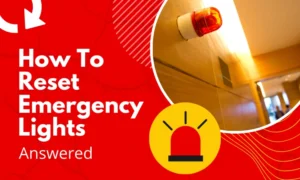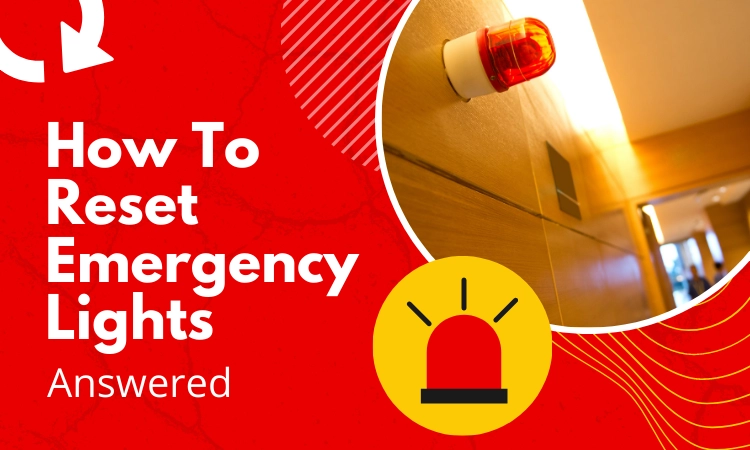Emergency exit light is an important device during dire times. The system fitting of these emergency exit lights varies from regular lights.
So, when something goes wrong, you may get confused about how to fix it. But unlike regular lights, it has a reset option that can erase your worries.
So, how to reset emergency lights?
To reset the emergency light, locate the test button and press it down once. Give 5 seconds gap and press the button again. Do this twice. As the button gets pressed, the current flow in L1 gets cut off. When the button is released, the current flow reunites. By doing this two times, the emergency light gets reset.
Need more details about your emergency exit light? Then this is the right piece to read. Join us in the full discussion.
How You Can Reset Emergency Lights?

To reset emergency lights you have to press the test button two times. After pressing it once, give 5 seconds gap before pressing it again. This resets the exit light.
When you press down the test button it breaks the current flow in the L1 terminal. So, the light’s fitting reverts to emergency lighting.
When the test button is released, it reconnects the current flow with the L1 terminal. This process needs to be performed twice to reset the emergency light. By resetting it’ll remove all the errors from the memory.
The memory of the emergency light is stored in the microcontroller. By resetting, the memory gets deleted. Afterward, the fixture performs a Short Function Test itself.
How To Know The Emergency Light Is Working?
Even after resetting your emergency light, you need to make sure that it’s working perfectly. There are three ways to figure out whether the emergency light is working properly or not.
- A green indicator LED will be illuminated on or beside each emergency light fixture. This indicates that the emergency fixture is operational and that its batteries are charging.
- If the configuration is unplugged from the power supply, the green LED indicator will turn off. Thus the fitting will illuminate using the power from the battery. This is yet another indication of proper operation.
- Emergency lighting needs to be assessed intermittently once a month and fully tested once a year. The test will bring out any problem with the emergency light.
The yearly test of the emergency light takes about 3 hours. A professional in this line should conduct the test as per Regulatory Safety Order 2005.
If your emergency light fails the test, it needs to be repaired. If the problem is not solved within a limited time frame, the fire safety committee has to be notified about this.
The test can be conducted along with a fire alarm inspection.
Inspection of fire alarms can also be done yearly. The cost of fire alarm inspection is quite reasonable. So, you can conduct both together.
Tips to Keep Your Emergency Lights Safe and Functional

You may need to troubleshoot your emergency light when a problem arises. However, emergency lights are not the same as regular household lights.
So, people face problems when trying to fix them. Here are some tips for troubleshooting an emergency light. Hopefully, this will help.
Learn The System:
Although emergency light fittings are different than normal light fittings, there are some major commonalities. So, if you get to learn how the system works, fixing them will be easier.
To learn the system, you need to know about the pieces of equipment and their roles. For example, the LED, test button, battery, emergency light module, housing, charging indicator, etc.
Their operation mechanism can be different. It’s either maintained or non-maintained. The maintained emergency light is illuminated permanently.
In the non-maintained mechanism, it is illuminated by a switch. Or, when the power supply gets cut off, it lits. The lights can be LED or fluorescent.
Keep Extra Batteries:
Solving the battery problem is probably the easiest fix. Just taking out the old battery and replacing it is all you need to do. But you need to have the battery at your hand when an emergency arises.
Emergency lights have very expensive batteries. So, naturally, the question of the expiration comes. Lithium Emergency light battery lasts about five years solid.
However, nickel metal hydride(NiMH) or nickel-cadmium(NiCd)batteries last about three years. Nevertheless, they are expensive.
So, don’t just throw them away before checking that it has indeed gone bad. Test the batteries with other emergency light units.
Make sure it’s not the dedicated charger that’s faulty. If the battery is in a poor state, keep a new battery in your hand. Know your options before choosing an emergency exit light battery.
Read Manuals:
Make a habit of consulting the manual when an issue arises. Simple fixes can be done by reading the manuals. Model and brand wise the fittings can be different.
The user manual can help you get through such problems.
Replace Circuit Board:
Sometimes the problem isn’t in the light fixtures but in the circuit board. If the fittings in the light seem to be correct, then move on to checking the circuit board.
See if the connections correspond to the right pin. Also, see if any connection has gotten severed. They need to be soldered again in the corresponding pin.
Now, before making any changes you should check the model documentation. It can be found in the user manual. You can use it to verify the connections.
While checking the circuit board you’d also have to remove the sub-chassis. Because it houses the circuit board.
White, green, and black wires are incoming alternating currents almost all of the time. Everything other wires make remote connections.
Maintenance And Testing For Emergency Light
Some emergency exit light remains lit all the time. So, it’s necessary that the emergency lights go through some regular maintenance and testing.
That way your emergency light will be functional for a sufficient period of time. There are two types of regular maintenance for emergency exit lights.
One is the visual inspection and the other is testing the battery.
Visual Inspection:
For the visual inspection, make sure you’ve checked the following-
- Check for any loose or exposed wiring in the light fitting and fix it if found. Exposed wires can cause electrical fire and loose wires can become entangled and cause further damage.
- The emergency light unit should be secured and properly mounted on the wall or ceiling.
- Check for any cracks in the light housing. Because water can seep through the crack and cause damage. You can use a protective guard to shelter them from external damage.
Battery Test:
The next is the battery inspection. Most emergency light failure is caused by a faulty battery. So, it’s important that you keep track of the battery’s health.
There are two types of battery tests you can conduct on your emergency lights. One is the 90-minute battery test and the other is the 90 minute load test.
The 30 seconds battery test can be conducted daily. The 90 minutes load test is conducted monthly. Here’s how to conduct them.
30-Second Battery Test
You can conduct the 30 seconds battery test in the following ways.
Method-1: Manual Testing
Locate the bright red “push-to-test” button. Press it to turn off the main power so the backup battery is activated. Make sure that the light is illuminated.
Keep holding the button down for 30 seconds. If the light didn’t flicker and stayed illuminated the whole time, then it passed the test.
If the light flickers or turns off then either the battery or the bulb is faulty. You can consult a technician regarding this problem. This battery test is suitable for facilities with a small number of units.
Method-2: Self-Diagnostic / Self-Testing
Press the “push-to-test” button twice to start the 30-second test. After 30 seconds, examine the LED indicator. If it’s green (steady, double-blink, or triple-blink) then it indicates normal service.
Whereas the red indicator (steady, double-blink, or triple-blink) suggests a failure of some kind. Lastly, press the “push-to-switch” button one more time. It resets the emergency light.
This method is suitable for facilities with lots of units.
90-Minute Battery Test:
The 90-minute load battery test is a lot similar to the 30-second battery. It can also be done manually or in a self-diagnostic way.
Method-1: Manual Testing
The process and the goal are the same as the 30-second test. Except a clamp is used to keep the button pressed down for the entire 90 minutes.
Method-2: Self-Diagnostic / Self-Testing
This is also the same as before. Except the push-to-test button has to be pressed down four times for the test to start.
Both 30-second and 90-minute load tests can be fully controlled by computer-based self-testing as well. But only authorized people can conduct these tests.
Frequently Asked Questions (FAQs):
Do emergency lights need to be on a dedicated circuit?
No, emergency lights do not require a dedicated circuit. But they need to be connected to the primary circuit. Because it’s the main source of power for the emergency light. The battery power is used as a backup.
What triggers the emergency exit light?
A power failure triggers the emergency exit light. The device is battery-powered. However, it’s connected to the electrical supply of the building from where the battery gets charged. When a power failure takes place, the circuitry activates the lights. So that others can see it during an emergency.
Why is my emergency light flashing?
If the emergency exit light is flashing green or red, it means the battery is getting charged. But the red light flashing might indicate a fault or a service alert as well. If it is flashing green light then it means the unit is in test mode.
Conclusion
That was all about how to reset emergency lights. Hopefully, you found the pieces of information useful and easy to apply in real-time.
Don’t forget to schedule emergency light inspections from time to time. It’ll lengthen the emergency light’s service life.
That’s it for today. Wishing you all the very best!

